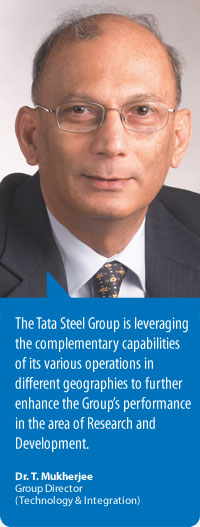Technology Absorption through Integration
A collaborative approach towards integration and the cross fertilisation of better practices are driving the Tata Steel Group Vision of being the world steel benchmark in value creation and corporate citizenship.
The last year has seen the Tata Steel Group move into the next phase of integration. Among the various initiatives that have been set into motion during this period, are several successful models that include a collaborative approach, cross fertilisation of better practices, imbibing and internalising the ongoing approach of process improvement, all of which are working towards the Tata Steel Group Vision of becoming the world steel benchmark in value creation and corporate citizenship.
All these practices have led to some substantial and measurable results that have enabled the Group to move forward on the defined path – especially in the area of Research and Development and Technology.
The hot strip mill and the cold rolling mill of the Jamshedpur plant in India have throughput figures well beyond the rated capacity. This has been successfully achieved as several ideas that had been implemented and proved to be successful models in Corus UK, were adapted for use in Tata Steel. The availability of blast furnaces and coke ovens at Jamshedpur has also improved by absorbing many ideas from Corus. In turn, the steel plant in South Wales has adopted ideas from Tata Steel slab casters to improve its productivity and reduce consumption of ferro alloys and refractories.
Drawing from Tata Steel’s extensive experience in the use of low cost coals, Corus plants have increased the use of low cost coals without affecting coke quality. The various steel works are using their collective experience in the process of reducing, if not eliminating the use of purchased coke. Similarly, the plants are finding new ways of recycling waste generated by the steel plants.
Integration in the technology area is being achieved through the pursuit of a few thrust area projects. The Tata Steel Group is leveraging the Group’s collective Research and Development experience in the Group’s various geographies to further enhance the Group’s performance and also the integration process. This has helped in speeding up the rate of progress and has enhanced chances of successful implementation. A new high efficiency coated product for automotive and for construction is a good example. Another example worth mentioning is a process that has been developed to produce hydrogen rich fuel gas by making use of the high heat energy, which is now being wasted away in the different plants.
In addition to manufacturing and technology development, much progress has been made in areas like Information Technology, Human Resources, and other support functions. These are expected to result in synergies much beyond the initial target of USD 450 million.
The journey commenced with the will to understand each other, appreciate the differing work cultures and the impact of history on the different organisations. The time spent in arriving at a common performance culture, and in developing and instituting an agreed operating model, has helped quicken the pace and unshackle barriers.
The way forward is, however, not without challenges. Effective use of Information Technology and developing teams across functional and geographic boundaries are areas where the Group will continue to focus.
A major achievement in the integration process has been the holistic approach towards integration that has created a feeling of belonging to a larger family within the Tata Steel Group.


